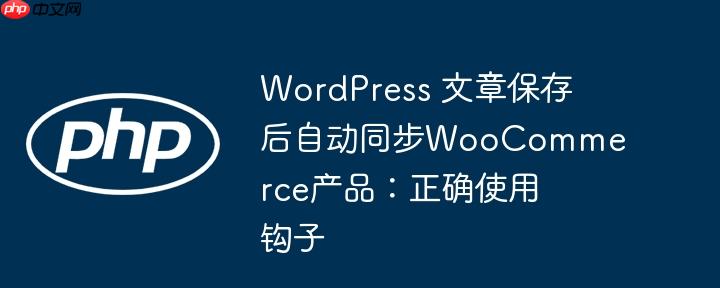
在wordpress开发中,我们经常需要在文章(post)被创建或更新后触发自定义逻辑。一个常见的场景是,当特定自定义文章类型(cpt)的文章被保存时,需要根据其内容(特别是高级自定义字段,acf)来创建或更新另一个cpt,例如将一个“奖项类别”文章的详细信息同步到woocommerce产品。
开发者通常会自然地想到使用save_post_{post_type}这样的动作钩子。例如,add_action('save_post_award_category', 'your_function')。然而,一个普遍遇到的问题是,当这个钩子触发时,文章的某些数据,特别是高级自定义字段(ACF)中的值,可能尚未完全保存到数据库中。这导致在钩子回调函数中尝试获取这些字段时,得到的是空值、旧值或不完整的数据,从而使同步逻辑失败。
问题的根本原因在于save_post系列钩子的执行时机。它们在文章数据(如标题、内容、状态)被保存后立即触发,但在所有元数据(包括ACF字段)被写入数据库之前。为了确保获取到最新的、完整的文章数据,我们需要一个在所有数据都已持久化后才执行的钩子。
WordPress 5.6.0 及更高版本引入了一个名为 wp_after_insert_post 的动作钩子,它专门设计用于在文章、其分类法和元数据全部保存到数据库之后触发。这正是解决上述ACF数据同步问题的理想选择。
wp_after_insert_post 钩子的签名如下:
/** * Fires once a post, its terms and meta data has been saved. * * @since 5.6.0 * * @param int $post_id Post ID. * @param WP_Post $post Post object. * @param bool $update Whether this is an existing post being updated. * @param null|WP_Post $post_before Null for new posts, the WP_Post object prior * to the update for updated posts. */ add_action( 'wp_after_insert_post', 'your_function_name', 10, 4 );
它提供了四个参数,这些参数对于构建健壮的同步逻辑至关重要:
以下代码演示了如何使用 wp_after_insert_post 钩子,将自定义文章类型“award_category”的ACF字段数据同步到WooCommerce产品。
/**
* 在“award_category”文章保存后,创建或更新相应的WooCommerce产品。
* 此函数在文章、其分类法和元数据全部保存后执行。
*
* @param int $post_id 当前保存的文章ID。
* @param WP_Post $post 当前文章对象。
* @param bool $update 是否为更新操作。
*/
function sync_award_category_to_product( $post_id, $post, $update ) {
// 确保只处理 'award_category' 类型的文章
if ( get_post_type( $post_id ) !== 'award_category' ) {
return;
}
// 获取文章名称,用于查找或创建产品
$post_name = $post->post_name;
// 尝试根据文章名称查找现有WooCommerce产品
// 注意:get_page_by_path 默认查找 'post' 类型,需要指定 'product'
$product_post = get_page_by_path( $post_name, OBJECT, 'product' );
$product_id = 0;
if ( ! $product_post ) {
// 如果产品不存在,则创建新产品
$product_id = wp_insert_post( array(
'post_title' => get_the_title( $post_id ), // 使用文章标题作为产品标题
'post_type' => 'product',
'post_status' => 'publish',
) );
if ( is_wp_error( $product_id ) ) {
// 错误处理:记录日志或通知管理员
error_log( 'Failed to create WooCommerce product for award category ' . $post_id . ': ' . $product_id->get_error_message() );
return;
}
} else {
// 如果产品已存在,则获取其ID
$product_id = $product_post->ID;
// 可选:更新现有产品的标题或其他基础信息
wp_update_post( array(
'ID' => $product_id,
'post_title' => get_the_title( $post_id ),
) );
}
// 确保产品ID有效
if ( $product_id ) {
// 获取 'award_category' 文章的 ACF 字段 'all_fields' 中的 'description'
// 注意:get_field 在此阶段可以安全地获取到最新的ACF数据
$award_category_description = get_field( 'description', $post_id );
// 更新 WooCommerce 产品的 'description' ACF 字段
// 假设WooCommerce产品也有一个名为 'description' 的ACF字段
if ( $award_category_description ) {
update_field( 'description', $award_category_description, $product_id );
}
// 如果需要同步其他ACF字段,可在此处添加更多 update_field 调用
// 例如:$some_other_field = get_field('some_other_field_key', $post_id);
// update_field('product_some_other_field_key', $some_other_field, $product_id);
}
}
// 注册动作钩子,优先级为10,接受4个参数
add_action( 'wp_after_insert_post', 'sync_award_category_to_product', 10, 4 );正确选择WordPress动作钩子是确保数据完整性和同步逻辑按预期工作的关键。对于需要在文章及其所有元数据(包括ACF字段)完全保存后执行操作的场景,wp_after_insert_post 钩子(适用于WordPress 5.6.0+)是目前最推荐和最可靠的解决方案。通过利用此钩子,开发者可以避免常见的因数据未完全写入而导致的问题,从而构建出更健壮、更可靠的WordPress应用。
以上就是WordPress 文章保存后自动同步WooCommerce产品:正确使用钩子的详细内容,更多请关注php中文网其它相关文章!

每个人都需要一台速度更快、更稳定的 PC。随着时间的推移,垃圾文件、旧注册表数据和不必要的后台进程会占用资源并降低性能。幸运的是,许多工具可以让 Windows 保持平稳运行。

Copyright 2014-2025 https://www.php.cn/ All Rights Reserved | php.cn | 湘ICP备2023035733号